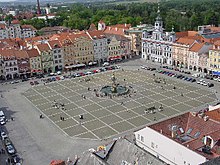| Revision as of 08:08, 22 August 2007 editMikeshk (talk | contribs)Extended confirmed users2,153 editsm Map background← Previous edit | Revision as of 09:34, 22 August 2007 edit undo77.48.45.227 (talk) →Sister cities and twin townsNext edit → | ||
| Line 172: | Line 172: | ||
| * {{flagicon|DEU}} ], ] | * {{flagicon|DEU}} ], ] | ||
| * {{flagicon|DEU}} ], ] | * {{flagicon|DEU}} ], ] | ||
| * {{flagicon| |
* {{flagicon|FRA}} ], ] | ||
| * {{flagicon| |
* {{flagicon|SVK}} ], ] | ||
| ==External links== | ==External links== | ||
Revision as of 09:34, 22 August 2007


České Budějovice (IPA: [ˈtʃɛskɛː ˈbuɟɛjovɪtsɛ]; short form: Budějovice; Template:Lang-de), often referred to simply as Budweis in English) is a city in the Czech Republic. It is the largest city in the South Bohemian Region and is the political and commercial capital of the region and centre of catholic Diocese of České Budějovice. The town is not to be confused with Moravské Budějovice in Moravia.
History
The town was founded by Hirzo, a knight of King Ottokar II of Bohemia, and was granted its city status in 1265. The royal city was created as platform of king's power in South Bohemia and counterbalance of powerful aristocratic House of Witigonen also lately known as House of Rosenberg (the most powerful stem of Witigonen). House of Witigonen died out in 1611. After this, city was a strong platform of sceptre in time of Habsburg Dynasty. The Town was a German-speaking enclave until 1890. During the industrialization Czechs won the ethnic majority. Until the mass expulsion of 1945 Budweis had a significant German minority (ca 15,5 % in 1930).
Beer
České Budějovice has long been well known for the beer brewed here since the 13th century. For a time the town was the royal brewery for the Emperor of the Holy Roman Empire, and beer from Budweis (the German name for České Budějovice), or "Budweiser Beer", attained fame. Beer brewing remains a major industry here.
The largest brewery is Pivovar Budějovický Budvar, which has legal rights to market its beer under the "Budweiser" brand name in much of Europe. The same product is also sold elsewhere under the names "Budvar" and "Czechvar" due to legal squabbles with Anheuser-Busch over the Budweiser brand. The American lager was originally brewed as an imitation of the famous Czech original but over time has developed its own identity and attained remarkable commercial success. Anheuser-Busch has made offers to buy out the Czech brewing company in order to secure global rights to the name "Budweiser", but the Czech government has refused all such offers, considering keeping the Budweiser name Czech to be a matter of national pride.
The second largest brewery, Pivovar Samson, also does a fair amount of export, mostly under the "Samson" and "Crystal" labels as well as "B. B. Bügerbräu", which has been in the US since last year.
Geography
The city is in the center of a valley of the Vltava River, where the Vltava meets the Malše river.
Sights
The old town preserves interesting Medieval and Baroque architecture around the large town square, including the old town hall with murals and bronze gargoyles, and the town tower "Černá věž" ("Black Tower"). In the new town the Belle Epoque Austro-Hungarian train station is notable. The most valuable historical building in České Budějovice is Dominican convent with gothic church Presentation of Virgin Mary on Piaristic square. The horse-drawn railroad line connecting České Budějovice to Linz was the oldest public line in continental Europe, constructed from 1824 to 1832; mere traces of the line can be seen south of the city center.
The ruins of the home castle of the Czech national hero Jan Žižka, Trocnov, are located some ten kilometres southeast from the town. A bit further away (cca 30km), the enchanting town of Český Krumlov is another compulsory stop for the visitor of South Bohemia. It was added in 1992 to UNESCO's World Heritage list.
Transport
Local bus and trolley bus routes take passengers to most areas of the city. The city itself can be reached from other locations by inter-city buses and by train. Internationally, a direct railroad line connecting Prague to Venice, Italy also makes a stop in Ceske Budejovice.
Miscellaneous
It is home to the University of South Bohemia and an Academy of Sciences.
It was the birthplace of:
- Richard Bernaschek, Austrian politician SPÖ
- Rudolf Hieronymus Eusebius von Colloredo-Waldsee, Austrian aristocrat
- Adalbert Gyrowetz (Vojtěch Jírovec), Austrian-Bohemian composer
- Marie Horáková, Bohemian actress
- Karl Adalbert Lanna, Austrian industrialist
- Haro Senft, Bohemian director and producer
- Adrian Molk, Austrian magician
- František Straka, Czech soccer player/coach
- Rolf Thiele, Austrian director and producer
- Vladimír Remek, Czech astronaut
- Karel Roden, Teuto-Czech actor
- Václav Prospal, Czech ice hockey leftwinger
- Veronika Zemanová, Czech model
- Petra Skálová, Czech model
The city is also one of the major settings in the novel "The Good Soldier: Švejk" by Jaroslav Hašek.
Sister cities and twin towns
External links
- Virtual Tourist tour of České Budějovice
- University of South Bohemia
- Region of České Budějovice
- Ceske Budejovice - tourism, basic facts, hotels
- Text of European Court of Justice decision in the "Budweiser" trademark case
- "Švejk Central": Web site devoted to the Hašek novel
- Budejovice.com
- Výnos ministerstva vnitra ČSR č.j. 10.454/20, Věstník ministerstva vnitra republiky československé, II. ročník, 1920